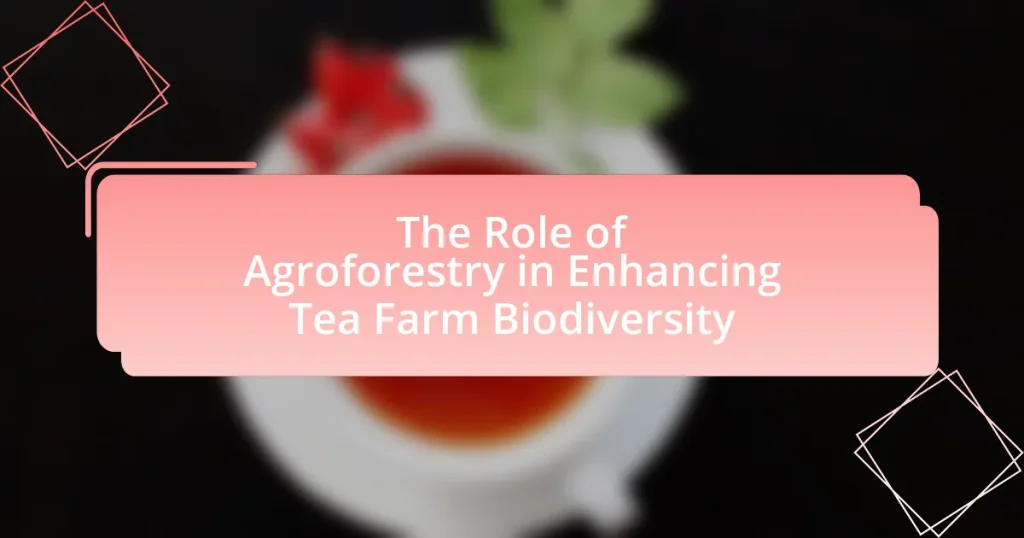Agroforestry is a sustainable agricultural practice that integrates trees and shrubs into tea farming systems, significantly enhancing biodiversity on tea farms. This article explores the various ways agroforestry contributes to increased habitat diversity, improved soil health, and effective pest management, leading to higher tea yields and quality. Key practices such as intercropping, shade management, and the integration of native vegetation are discussed, along with the ecological and economic benefits they provide to tea farmers. Additionally, the article addresses challenges faced by farmers in adopting agroforestry and highlights the role of technology and policy in promoting these practices for sustainable tea production.

What is the role of agroforestry in enhancing tea farm biodiversity?
Agroforestry plays a crucial role in enhancing tea farm biodiversity by integrating trees and shrubs into tea cultivation systems. This practice increases habitat diversity, which supports a wider range of species, including beneficial insects and birds that contribute to pest control and pollination. Research indicates that agroforestry systems can improve soil health and water retention, further promoting a diverse ecosystem. For instance, a study published in the journal “Agriculture, Ecosystems & Environment” found that tea farms with agroforestry practices had 30% higher species richness compared to conventional tea farms, demonstrating the significant impact of this approach on biodiversity.
How does agroforestry contribute to biodiversity on tea farms?
Agroforestry enhances biodiversity on tea farms by integrating trees and shrubs with tea cultivation, creating diverse habitats for various species. This practice increases the number of plant and animal species by providing food, shelter, and breeding grounds, which are essential for ecological balance. Research indicates that agroforestry systems can support up to 30% more species compared to monoculture tea farms, as diverse plantings attract beneficial insects and wildlife, promoting pollination and pest control. Additionally, the presence of trees improves soil health and water retention, further supporting a wider range of organisms.
What specific practices in agroforestry promote biodiversity in tea cultivation?
Agroforestry practices that promote biodiversity in tea cultivation include intercropping, shade management, and the integration of native vegetation. Intercropping involves planting tea alongside other crops, which enhances habitat diversity and supports various species. Shade management, by maintaining tree cover, creates a microclimate that benefits both tea plants and associated flora and fauna. The integration of native vegetation provides food and habitat for local wildlife, further enriching the ecosystem. Studies have shown that these practices can increase species richness and improve ecological resilience in tea farming systems.
How does the integration of trees and shrubs affect tea farm ecosystems?
The integration of trees and shrubs into tea farm ecosystems enhances biodiversity and improves soil health. This practice creates a more complex habitat that supports a variety of organisms, including beneficial insects and birds, which can aid in pest control and pollination. Research indicates that agroforestry systems, which incorporate trees and shrubs, can increase soil organic matter by up to 30%, leading to improved nutrient retention and reduced erosion. Additionally, the shade provided by trees can help regulate temperature and moisture levels, creating a more favorable microclimate for tea plants. These ecological benefits contribute to the overall resilience and productivity of tea farms.
Why is biodiversity important for tea farms?
Biodiversity is crucial for tea farms because it enhances ecosystem resilience, improves pest control, and promotes soil health. A diverse range of plants and animals contributes to a balanced ecosystem, which can naturally regulate pests and diseases, reducing the need for chemical pesticides. Additionally, various plant species can improve soil structure and fertility, leading to better water retention and nutrient availability. Studies have shown that tea farms with higher biodiversity can yield better quality tea and sustain production over time, as diverse ecosystems are more adaptable to environmental changes.
What ecological benefits does biodiversity provide to tea farming?
Biodiversity provides essential ecological benefits to tea farming by enhancing soil health, pest control, and pollination. Diverse plant and animal species contribute to improved soil structure and nutrient cycling, which are critical for tea plant growth. For instance, studies show that agroforestry systems with diverse species can increase soil organic matter by up to 30%, leading to better water retention and fertility. Additionally, a variety of natural predators in biodiverse environments can effectively manage pest populations, reducing the need for chemical pesticides. Furthermore, diverse flowering plants attract a range of pollinators, which are vital for the reproductive success of tea plants. Research indicates that farms with higher biodiversity can experience up to a 50% increase in pollination services, directly benefiting tea yield and quality.
How does biodiversity influence tea quality and yield?
Biodiversity significantly influences tea quality and yield by enhancing ecosystem resilience and promoting beneficial interactions among species. Diverse plant and animal species contribute to improved soil health, pest control, and pollination, which are crucial for optimal tea growth. For instance, studies have shown that tea farms with higher biodiversity levels experience reduced pest outbreaks and improved nutrient cycling, leading to higher yields and better-quality leaves. Research conducted by the International Centre for Research in Agroforestry indicates that agroforestry systems, which integrate diverse species, can increase tea yields by up to 30% compared to monoculture systems, demonstrating the direct impact of biodiversity on tea production.
What challenges do tea farmers face in implementing agroforestry?
Tea farmers face several challenges in implementing agroforestry, primarily including land competition, initial investment costs, and knowledge gaps. Land competition arises as farmers must allocate space for both tea cultivation and additional trees, which can limit available land for tea production. Initial investment costs are significant, as establishing agroforestry systems requires financial resources for planting trees and managing the new ecosystem. Knowledge gaps also pose a challenge, as many farmers lack the necessary training and information on agroforestry practices, which can lead to ineffective implementation and management. These challenges hinder the adoption of agroforestry, despite its potential benefits for enhancing biodiversity on tea farms.
What are the common misconceptions about agroforestry in tea farming?
Common misconceptions about agroforestry in tea farming include the belief that it reduces tea yield and complicates management practices. In reality, agroforestry can enhance tea production by improving soil health and increasing biodiversity, which leads to better pest control and resilience against climate change. Research indicates that integrating trees with tea crops can boost overall farm productivity by up to 30%, as demonstrated in studies conducted in regions like Sri Lanka and India. Additionally, some assume that agroforestry requires extensive land, but it can be implemented on small plots, making it accessible for smallholder farmers.
How can farmers overcome barriers to adopting agroforestry practices?
Farmers can overcome barriers to adopting agroforestry practices by accessing education and training programs that demonstrate the benefits and techniques of agroforestry. Research indicates that targeted training can increase farmers’ knowledge and confidence, leading to higher adoption rates. For instance, a study by the World Agroforestry Centre found that farmers who participated in agroforestry training increased their implementation of these practices by 40%. Additionally, establishing financial incentives, such as subsidies or grants, can alleviate the economic burden associated with initial investments in agroforestry systems. This approach has been supported by various agricultural development programs that report improved adoption rates when financial support is provided.
How can agroforestry practices be effectively implemented in tea farming?
Agroforestry practices can be effectively implemented in tea farming by integrating tree species that enhance biodiversity and improve soil health alongside tea plants. This integration can involve planting shade trees, such as Grevillea robusta, which provide canopy cover, reduce soil erosion, and create a microclimate conducive to tea growth. Research indicates that such practices can increase tea yield by 20-30% while also promoting beneficial insect populations, which are crucial for pest control. Additionally, incorporating nitrogen-fixing trees can enhance soil fertility, leading to healthier tea plants and improved overall farm productivity.
What are the best agroforestry models for enhancing tea farm biodiversity?
The best agroforestry models for enhancing tea farm biodiversity include intercropping, alley cropping, and shade tree integration. Intercropping involves planting tea alongside compatible crops, which can increase species diversity and improve soil health. Alley cropping combines tea cultivation with rows of trees, providing habitat for wildlife and enhancing nutrient cycling. Shade tree integration allows for the cultivation of tea under the canopy of trees, which can protect tea plants from extreme weather and promote a diverse ecosystem. Research indicates that these models can significantly increase biodiversity, improve pest control, and enhance overall farm resilience.
How can farmers measure the success of agroforestry in their tea farms?
Farmers can measure the success of agroforestry in their tea farms by evaluating biodiversity indicators, soil health, and economic returns. Biodiversity indicators include the variety and abundance of plant and animal species present, which can be assessed through regular surveys and monitoring. Soil health can be measured through soil tests that analyze nutrient levels, organic matter content, and microbial activity, all of which are enhanced by agroforestry practices. Economic returns can be quantified by comparing yields and profits from tea production before and after implementing agroforestry systems, with studies showing that agroforestry can increase tea yields by up to 20% due to improved ecosystem services.

What are the environmental impacts of agroforestry on tea farms?
Agroforestry on tea farms positively impacts the environment by enhancing biodiversity, improving soil health, and increasing carbon sequestration. The integration of trees and shrubs with tea cultivation creates diverse habitats that support various species, leading to increased ecological resilience. Studies indicate that agroforestry systems can enhance soil fertility through organic matter addition and nutrient cycling, which is crucial for sustainable tea production. Furthermore, agroforestry practices contribute to carbon sequestration, with estimates suggesting that such systems can sequester up to 30% more carbon compared to conventional monoculture tea farms. This multifaceted approach not only supports tea production but also promotes environmental sustainability.
How does agroforestry improve soil health in tea cultivation?
Agroforestry improves soil health in tea cultivation by enhancing soil structure, increasing organic matter, and promoting biodiversity. The integration of trees and shrubs with tea plants contributes to better soil aeration and water retention, which are crucial for root development. Additionally, the organic matter from leaf litter and root biomass enriches the soil, leading to higher nutrient availability. Research indicates that agroforestry systems can increase soil organic carbon levels by up to 30% compared to conventional monoculture practices, thereby improving soil fertility and microbial activity. This enhanced microbial diversity further supports nutrient cycling, which is vital for the health of tea plants.
What role do trees play in soil erosion prevention on tea farms?
Trees play a crucial role in preventing soil erosion on tea farms by stabilizing the soil with their root systems. The roots of trees bind the soil together, reducing the risk of soil displacement caused by water runoff and wind. Additionally, trees provide canopy cover that protects the soil from direct rainfall impact, which can lead to erosion. Research indicates that agroforestry practices, which integrate trees into tea farming, can significantly decrease soil erosion rates by up to 50% compared to conventional farming methods. This protective function of trees not only preserves soil quality but also enhances the overall biodiversity of tea farms, contributing to a more sustainable agricultural ecosystem.
How does agroforestry enhance water retention in tea-growing areas?
Agroforestry enhances water retention in tea-growing areas by integrating trees with tea plants, which improves soil structure and increases organic matter. The presence of tree roots helps to create channels in the soil, allowing for better infiltration of water and reducing surface runoff. Additionally, the canopy cover provided by trees reduces evaporation rates, maintaining higher moisture levels in the soil. Research indicates that agroforestry systems can increase soil moisture retention by up to 30%, thereby supporting tea plants during dry periods and improving overall yield and quality.
What effects does agroforestry have on pest management in tea farms?
Agroforestry positively impacts pest management in tea farms by enhancing biodiversity and promoting natural pest control mechanisms. The integration of trees and shrubs within tea plantations creates habitats for beneficial insects, such as predators and parasitoids, which help regulate pest populations. Research indicates that agroforestry systems can reduce pest incidence by up to 50% compared to monoculture systems, as diverse plant species disrupt pest life cycles and provide alternative food sources for natural enemies. Additionally, the presence of diverse flora can improve soil health and resilience, further supporting a balanced ecosystem that mitigates pest outbreaks.
How can biodiversity reduce pest populations in tea cultivation?
Biodiversity can reduce pest populations in tea cultivation by promoting natural pest control mechanisms through the presence of various species that act as predators or parasites to pests. For instance, a diverse ecosystem can support beneficial insects, such as ladybugs and lacewings, which feed on aphids and other harmful pests. Research indicates that farms with higher biodiversity experience lower pest densities, as these ecosystems create a balance that discourages pest outbreaks. A study published in the journal “Agriculture, Ecosystems & Environment” by Tscharntke et al. (2012) found that increased plant diversity in agroforestry systems enhances the abundance of natural enemies, leading to effective pest regulation.
What are the implications of agroforestry for organic pest control in tea farming?
Agroforestry significantly enhances organic pest control in tea farming by promoting biodiversity and creating a balanced ecosystem. The integration of trees and shrubs alongside tea plants provides habitats for beneficial insects, such as predators and parasitoids, which naturally regulate pest populations. Research indicates that agroforestry systems can reduce pest incidence by up to 50% compared to monoculture systems, as diverse plantings disrupt pest life cycles and enhance the presence of natural enemies. Additionally, the presence of various plant species can improve soil health and resilience, further supporting the overall health of tea crops and reducing reliance on chemical pesticides.
What are the social and economic benefits of agroforestry for tea farmers?
Agroforestry provides significant social and economic benefits for tea farmers by enhancing biodiversity, improving soil health, and increasing income stability. The integration of trees with tea cultivation promotes a diverse ecosystem that supports beneficial insects and reduces pest populations, leading to healthier tea plants and potentially higher yields. Economically, agroforestry systems can diversify income sources through the sale of timber, fruits, or other tree products, which can buffer farmers against market fluctuations in tea prices. Studies have shown that tea farmers practicing agroforestry can experience up to a 30% increase in overall farm income due to these diversified products and improved crop resilience. Additionally, agroforestry practices contribute to community well-being by fostering social cohesion through shared management of resources and enhancing food security through increased crop diversity.
How does agroforestry contribute to the livelihoods of tea farmers?
Agroforestry contributes to the livelihoods of tea farmers by enhancing biodiversity, improving soil health, and providing additional income sources. By integrating trees and shrubs with tea cultivation, farmers benefit from increased ecosystem services such as pest control and pollination, which lead to higher tea yields. Research indicates that agroforestry systems can increase tea production by up to 30% due to improved microclimates and reduced soil erosion. Additionally, farmers can harvest fruits, nuts, and timber from the trees, diversifying their income and reducing reliance on tea alone. This multifaceted approach not only stabilizes farmers’ incomes but also promotes sustainable agricultural practices.
What role does agroforestry play in community resilience for tea farming regions?
Agroforestry enhances community resilience in tea farming regions by diversifying income sources and improving ecosystem stability. By integrating trees with tea crops, farmers can benefit from additional products such as fruits, nuts, and timber, which provide financial security against market fluctuations. Furthermore, agroforestry practices improve soil health and water retention, reducing vulnerability to climate change impacts like droughts and floods. Studies indicate that regions practicing agroforestry experience increased biodiversity, which supports pest control and pollination, further stabilizing tea production. For instance, research published in the Journal of Sustainable Agriculture highlights that agroforestry systems can increase crop yields by up to 30% compared to monoculture practices, demonstrating their effectiveness in enhancing resilience.

What are the future prospects of agroforestry in tea farming?
The future prospects of agroforestry in tea farming are promising, as it enhances biodiversity, improves soil health, and increases resilience to climate change. Agroforestry practices, such as intercropping tea with native trees and shrubs, can lead to a more diverse ecosystem, which supports beneficial insects and reduces pest populations. Research indicates that integrating trees into tea plantations can improve microclimates, leading to better tea quality and yield. For instance, a study published in the Journal of Sustainable Agriculture found that tea farms with agroforestry systems had a 20% increase in biodiversity compared to monoculture systems. This diversification not only supports ecological balance but also provides additional income sources for farmers through timber and non-timber forest products.
How can technology enhance agroforestry practices in tea cultivation?
Technology can enhance agroforestry practices in tea cultivation by improving resource management and increasing crop yields. Precision agriculture technologies, such as drones and satellite imagery, enable farmers to monitor soil health, moisture levels, and pest populations, allowing for targeted interventions that optimize growth conditions. For instance, a study published in the Journal of Agricultural Science found that using remote sensing technology can increase tea yield by up to 20% by providing real-time data for better decision-making. Additionally, mobile applications facilitate knowledge sharing among farmers, promoting sustainable practices and biodiversity conservation. These advancements demonstrate that integrating technology into agroforestry can lead to more efficient and sustainable tea cultivation.
What innovations are emerging in agroforestry for tea farms?
Innovations emerging in agroforestry for tea farms include the integration of shade trees, intercropping with legumes, and the use of agroecological practices. Shade trees, such as Grevillea robusta, enhance biodiversity by providing habitat for various species and improving microclimates, which can lead to increased tea yield and quality. Intercropping with legumes, like cowpeas, enriches soil fertility through nitrogen fixation, reducing the need for chemical fertilizers. Additionally, agroecological practices, such as organic pest management and cover cropping, promote sustainable farming and enhance ecosystem services. These innovations are supported by research indicating that agroforestry systems can increase biodiversity and improve resilience against climate change, ultimately benefiting tea production.
How can data-driven approaches improve agroforestry outcomes in tea farming?
Data-driven approaches can significantly improve agroforestry outcomes in tea farming by optimizing resource management and enhancing biodiversity. Utilizing data analytics allows farmers to monitor soil health, weather patterns, and crop performance in real-time, leading to informed decision-making. For instance, precision agriculture techniques, such as remote sensing and GIS mapping, enable farmers to identify the best planting times and crop combinations, which can increase yields and reduce resource waste. Research indicates that integrating diverse plant species in tea farming systems can enhance ecosystem services, such as pest control and pollination, ultimately leading to more resilient agricultural systems. A study published in the journal “Agroforestry Systems” found that farms employing data-driven methods experienced a 20% increase in biodiversity and a 15% improvement in overall productivity compared to traditional practices.
What policies support agroforestry initiatives in tea farming?
Policies that support agroforestry initiatives in tea farming include government incentives for sustainable land use, financial assistance programs for farmers adopting agroforestry practices, and regulations promoting biodiversity conservation. For instance, many countries implement subsidies that encourage tea farmers to integrate trees into their farming systems, which enhances soil health and biodiversity. Additionally, policies such as the United Nations’ Sustainable Development Goals advocate for sustainable agricultural practices, including agroforestry, to improve ecosystem services and resilience in agricultural landscapes. These policies are designed to create a supportive framework that encourages tea farmers to adopt agroforestry, ultimately leading to improved biodiversity and sustainability in tea farming.
How can government incentives promote agroforestry in the tea sector?
Government incentives can promote agroforestry in the tea sector by providing financial support and resources that encourage farmers to integrate trees into their tea plantations. These incentives can include subsidies for planting trees, tax breaks for agroforestry practices, and funding for research and development of agroforestry techniques specific to tea cultivation. For instance, studies have shown that agroforestry can enhance biodiversity, improve soil health, and increase resilience to climate change, which are critical factors for sustainable tea production. By financially supporting these practices, governments can facilitate the transition to agroforestry, leading to improved ecological outcomes and long-term economic benefits for tea farmers.
What role do NGOs play in advancing agroforestry practices among tea farmers?
NGOs play a crucial role in advancing agroforestry practices among tea farmers by providing education, resources, and support for sustainable farming methods. They facilitate training programs that teach farmers about the benefits of integrating trees with tea cultivation, which can enhance biodiversity, improve soil health, and increase resilience to climate change. For instance, organizations like the Rainforest Alliance have implemented initiatives that promote agroforestry, resulting in improved yields and environmental benefits for tea farmers. Additionally, NGOs often collaborate with local communities to develop agroforestry models tailored to specific ecological and socio-economic contexts, thereby ensuring the practices are both effective and culturally appropriate.
What practical steps can tea farmers take to implement agroforestry?
Tea farmers can implement agroforestry by integrating trees and shrubs into their tea plantations. This practice enhances biodiversity, improves soil health, and provides shade for tea plants. Farmers can start by selecting native tree species that complement tea growth, such as nitrogen-fixing trees, which enrich the soil. Additionally, they should design a planting layout that maximizes light and space efficiency, ensuring that tea plants receive adequate sunlight while benefiting from the protective canopy of trees.
Research indicates that agroforestry systems can increase biodiversity by providing habitats for various species, which can lead to improved pest control and pollination services. For instance, a study published in the journal “Agroforestry Systems” found that integrating trees into tea farms can increase the abundance of beneficial insects, thereby enhancing ecosystem services.
What resources are available for tea farmers interested in agroforestry?
Tea farmers interested in agroforestry can access various resources, including agricultural extension services, research institutions, and online platforms dedicated to sustainable farming practices. Agricultural extension services provide practical guidance and training on agroforestry techniques tailored to tea cultivation. Research institutions, such as the International Centre for Research in Agroforestry, offer studies and publications that detail the benefits and methods of integrating trees with tea crops. Additionally, online platforms like the Agroforestry Research Trust provide valuable information, case studies, and networking opportunities for farmers looking to implement agroforestry practices. These resources collectively support tea farmers in enhancing biodiversity and improving farm sustainability.
How can farmers start small with agroforestry on their tea farms?
Farmers can start small with agroforestry on their tea farms by integrating shade trees and companion crops alongside their tea plants. This approach enhances biodiversity, improves soil health, and provides additional income sources. For instance, planting nitrogen-fixing trees like Leucaena can enrich the soil, while intercropping with crops such as beans or vegetables can offer farmers supplementary harvests. Research indicates that agroforestry systems can increase overall farm productivity by up to 30% while promoting ecological balance, as demonstrated in studies conducted by the World Agroforestry Centre.


